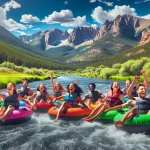Spanning over 713,000 acres across seven designated areas, this vast expanse of Colorado State forest areas, alpine lakes, and rolling mountains offers a bounty of year-round recreation amidst breathtaking scenery.
In This Article
From hiking and camping to fishing and wildlife viewing, the state forest provides endless opportunities to connect with nature and discover Colorado’s diverse landscapes firsthand. Its rich habitat sustains an abundance of flora and fauna, while its peaks and valleys tell stories of the state’s past. As a managed National forest, it also serves as an outdoor classroom to learn about conservation, fire ecology, and sustainable practices through educational programs and volunteer projects.
Whether you’re seeking adventure, rejuvenation, or environmental stewardship, the Colorado State Forest welcomes all to wander its trails and immerse in the splendor of western wilderness.
TL;DR
- Colorado State Forest spans over 713,000 acres with seven designated areas offering year-round outdoor recreation.
- Visitors can hike, camp, fish, view wildlife, and partake in winter activities amidst spectacular mountain scenery.
- As a managed forest, there are opportunities to learn about conservation, fire ecology, and sustainability.
A Majestic Mountain Playground
Blanketed in evergreen forests and dotted with shimmering lakes, the Colorado State Forest is a vast mountain wonderland perfect for escaping into nature. Its peaks and valleys protect one of the state’s last remaining intact forest ecosystems, providing critical habitat for wildlife and a living laboratory for researchers.
With elevations ranging from 8,000 to over 14,000 feet, the state forest encompasses diverse terrain. Alpine tundra, wildflower meadows, cascading streams, and remnants of ancient glaciers transport visitors into a world apart from everyday life. One can wander past whispering aspens or beneath towering ponderosa pines, the scent of pine needles underfoot. Over 300 bird species flit through the boughs while herds of elk and moose meander across meadows. At night, coyotes harmonize, and owls echo through the darkness as millions of stars ignite the night sky.
Whether seeking solitude on a rugged trail or gathering around a crackling campfire, the sense of freedom and timelessness in these protected wildlands heals the soul. The state forest remains largely primitive, with gravel roads twisting through the valleys and trails branching into the backcountry. While some areas offer developed campgrounds and facilities, much of the forest retains its wild spirit. As an escape from urban life, it promises adventure, renewal, and inspiration.
Here are some great Colorado forest and state park areas to visit:
- Rocky Mountain National Park
- Pikes Peak and Pike National Forest
- Roosevelt National Forest
- Eldorado Canyon State Park
- Arapaho National Forest
- North Michigan Reservoir
- Routt National Forest
- Alpine Lake
Immersing in Local Culture
Beyond its natural splendor, the state forest also offers glimpses into Colorado’s cultural heritage through its logging towns, historic sites, and community events. From indigenous Ute tribes and fur trappers to loggers, ranchers, and miners, these lands harbor stories of those who came before. Towns like Walden and Gould retain their rugged, small-town charm from their early timber days. Locals are eager to share tales of the forest, whether legends of 10-foot trout in North Michigan Reservoir or the rowdy days of early logging camps.
Visitors can experience history first-hand at preserved homesteads like the Fork Horn Ranch or the hauntingly preserved ghost town of Gaskill. Cultural events like the Buffalo Peaks Music Festival and North Park Pioneer Days Gathering celebrate the region’s folk music, cowboy poetry, traditional crafts, and Wild West roots. From train rides and gold panning to rodeos and country fairs, the local culture offers much to discover.
By meeting community members and participating in events, visitors gain a richer understanding of the forest’s cultural legacy and develop a deeper connection with the land and people.
Year-Round Outdoor Adventure
For outdoor enthusiasts, the state forest is a recreational paradise thanks to diverse landscapes that provide adventure across all seasons. Each area has its own unique offerings, from the desert-like canyon country of Pinyon Flats to the lush alpine terrain of Never Summer range.
Summer lures visitors with over 600 miles of hiking and biking trails. Whether meandering through wildflower meadows or climbing a rocky peak, paths cater to all abilities while delivering stunning alpine scenery. Adrenaline junkies can also set up camp and then tackle class III-V rapids on the Colorado River’s headwaters.
Anglers reel in record-breaking trout on secluded lakes or try their luck fly fishing the Cache La Poudre River. With plentiful campgrounds and backcountry access, visitors can easily immerse themselves in wildlands for days on end.
As autumn colors erupt, the forest blazes with golden aspens mingled with evergreen forests. Crisp air carries the hint of woodsmoke as people gather for the beloved Colorado tradition of elk bugling season.
In winter, the state forest transforms into a frozen kingdom. Backcountry skiers and snowshoers find endless powder-filled bowls and tree glades to explore. Groomed trails and pristine meadows offer family-friendly Nordic skiing and snowmobiling. After building snowmen and sledding, visitors can warm up by the fire with hot cocoa in hand and stars overhead.
With so much to experience across the seasons, the state forest guarantees an exhilarating adventure all year long.
Protecting the Wilderness
As a working, managed forest, Colorado State Forest focuses on balancing public recreation and environmental goals through responsible stewardship. Its designation protects habitat and watersheds to conserve sensitive alpine ecosystems in their natural state.
Ongoing projects help restore wildlife populations and habitats impacted by early 20th-century logging operations. Closure periods allow elk and deer undisturbed time in winter range areas, while stream rehabilitation improves spawning grounds. Tree thinning mitigates disease and reduces fire risk around communities.
Visitors play an important role by following Leave No Trace principles when camping, staying on designated trails, and packing out all trash. Well-managed campfires and proper food storage also help minimize human impact on the landscape.
For those interested in conservation, the state forest also offers opportunities to get involved through volunteer projects focused on sustainability, wildlife monitoring, trail maintenance, and forest health. Citizens can also participate in educational programs covering topics from fire ecology to environmental ethics. By engaging visitors as stewards of the land, the forest continues to foster connections between people and nature.
Know Before You Go
To fully enjoy your visit, be sure to plan ahead and prepare properly. Some key tips:
Permits:
Overnight camping permits are required and can be reserved online or purchased on-site. Fishing licenses are needed for anglers over the age of 16.
Weather:
Colorado weather is notoriously unpredictable. Check forecasts and prepare for sudden changes in all seasons.
Accessibility:
While some areas offer wheelchair-accessible facilities, much of the forest has limited access. Contact visitor centers for accessibility options.
Wildlife:
Properly store food/trash and keep safe distances from all wildlife to protect both visitors and animals.
Fire:
Check for local fire restrictions before having campfires. Use established fire rings only and fully extinguish fires.
Facilities:
Amenities like restrooms, potable water, developed campsites, and cell/data coverage vary across areas. Verify what’s available on forest service websites.
Regulations:
Know important rules like quiet hours, leash laws, fire restrictions, and where vehicles can operate before your visit.
As the saying goes, “Take only memories, leave only footprints.” Following park guidelines, environmental ethics, and respectful outdoor practices ensures the Colorado State Forest remains an unspoiled sanctuary for generations to come.
Reviews from the Forest
For those considering a visit, don’t just take our word for it. Here’s what past visitors have raved about their time in Colorado State Forest:
“We backpacked for three days and didn’t see another soul. It was so peaceful wandering alpine meadows filled with wildflowers while snow-capped peaks towered above. Can’t wait to return!”
“The developed campgrounds were gorgeous and made it easy to access trails for day hikes with our kids. We loved learning about fire ecology while our teenagers volunteered to clear brush as part of the forest’s restoration efforts. Unforgettable educational experience!”
“Caught some monster trout fly-fishing along the upper Colorado River. Guides shared great stories about the early logging days while wildlife was everywhere. Already planning another guys trip back next summer!”
Clearly, Colorado State Forest leaves lasting impressions on all who wander its trails. Whether you seek outdoor adventure, cultural connection, or environmental awareness, these protected wildlands promise transformative experiences that reconnect people with nature. As the Ute tribe once called these lands “the Shining Mountains,” this awe-inspiring landscape has been inspiring visitors for generations. Why not come discover its magic for yourself?
FAQ
What are the most popular areas to visit within the state forest?
Some of the most popular areas include State Forest State Park, with its wealth of recreational access, the Never Summer range for rugged alpine scenery, and North Michigan Reservoir for fishing and boating opportunities.
What wildlife might visitors see while hiking or camping?
Common sightings include elk, mule deer, moose, black bear, coyote, bobcat, yellow-bellied marmot, pine marten, bald eagle, osprey, wild turkey, and a variety of migratory songbirds.
Is dispersed backcountry camping allowed?
Yes, dispersed camping is allowed in certain areas, although some locations require permits. Verify regulations with local land agencies before planning backcountry trips.
Are dogs allowed on hiking trails and in campgrounds?
Dogs are allowed but must be leashed in campgrounds and other developed areas. Dogs must be under voice command or leashed in wilderness areas to minimize wildlife disturbances.
What are the most accessible campgrounds and trails?
State Forest State Park and Red Feather Lakes offer the most wheelchair-friendly campsites, fishing piers, and interpretive trails. Contact ranger stations for detailed accessibility information to meet specific needs.
How can people get involved with conservation and sustainability projects?
Volunteer opportunities are available through Colorado Youth Corps and conservation non-profits working in the forest. Visitors can also attend educational programming or participate in citizen science projects monitoring wildlife and forest health. Check with visitor centers and park websites for upcoming events.






